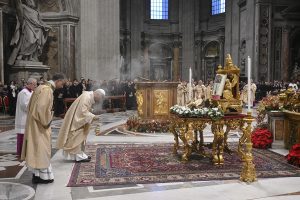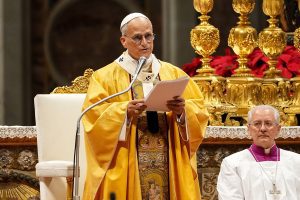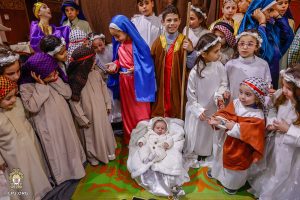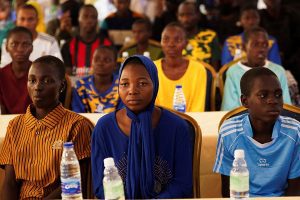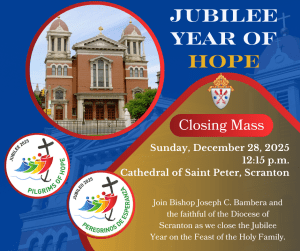(OSV News) — The following is the full text of the “urbi et orbi” blessing given by Pope Leo XIV on Christmas Dec. 25, 2025.

Dear brothers and sisters,
“Let us all rejoice in the Lord, for our Savior has been born in the world. Today, true peace has come down to us from heaven” (Entrance Antiphon, Christmas Mass during the Night). Thus sings the liturgy on Christmas night, and the announcement of Bethlehem resounds in the Church: the Child born of the Virgin Mary is Christ the Lord, sent by the Father to save us from sin and death. Indeed, he is our peace; he has conquered hatred and enmity through God’s merciful love. For this reason, “the Lord’s birth is the birth of peace” (Saint Leo the Great, Sermon 26).
Jesus was born in a stable because there was no room for him in the inn. As soon as he was born, his mother Mary “wrapped him in swaddling clothes, and laid him in a manger” (cf. Lk 2:7). The Son of God, through whom all things were created, was not welcomed, and a poor manger for animals was his crib.
The eternal Word of the Father whom the heavens cannot contain chose to come into the world in this way. Out of love, he wanted to be born of a woman and so share our humanity; out of love, he accepted poverty and rejection, identifying himself with those who are discarded and excluded.
Already in the birth of Jesus, we glimpse the fundamental decision that would guide the entire life of the Son of God, even to his death on the cross: the decision not to leave us under the burden of sin, but to bear it himself for us, to take it upon himself. He alone could do so. At the same time, however, he showed us what we alone can do, which is to take on our own share of responsibility. Indeed, God, who created us without us, will not save us without us (cf. Saint Augustine, Sermon 169, 11, 13), that is, without our free will to love. Those who do not love are not saved; they are lost. And those who do not love their brother or sister whom they see, cannot love God whom they do not see (cf. 1 Jn 4:20).
Sisters and brothers, responsibility is the sure way to peace. If all of us, at every level, would stop accusing others and instead acknowledge our own faults, asking God for forgiveness, and if we would truly enter into the suffering of others and stand in solidarity with the weak and the oppressed, then the world would change.
Jesus Christ is our peace first of all because he frees us from sin, and also because he shows us the way to overcome conflicts — all conflicts, whether interpersonal or international. Without a heart freed from sin, a heart that has been forgiven, we cannot be men and women of peace or builders of peace. This is why Jesus was born in Bethlehem and died on the cross: to free us from sin. He is the Savior. With his grace, we can and must each do our part to reject hatred, violence and opposition, and to practice dialogue, peace and reconciliation.
On this day of celebration, I wish to send a warm and fatherly greeting to all Christians, especially those living in the Middle East, whom I recently visited on my first Apostolic Journey. I listened to them as they expressed their fears and know well their sense of powerlessness before the power dynamics that overwhelm them. The Child born today in Bethlehem is the same Jesus who says: “In me you may have peace. In the world you have tribulation; but be of good cheer, I have overcome the world” (Jn 16:33).
From God let us ask for justice, peace and stability for Lebanon, Palestine, Israel and Syria, trusting in these divine words: “The effect of righteousness will be peace, and the result of righteousness, quietness and trust for ever” (Is 32:17).
Let us entrust the entire European continent to the Prince of Peace, asking him to continue to inspire a spirit of community and cooperation, in fidelity to its Christian roots and history, and in solidarity with – and acceptance of – those in need. Let us pray in a particular way for the tormented people of Ukraine: may the clamor of weapons cease, and may the parties involved, with the support and commitment of the international community, find the courage to engage in sincere, direct and respectful dialogue.
From the Child of Bethlehem, we implore peace and consolation for the victims of all current wars in the world, especially those that are forgotten, and for those who suffer due to injustice, political instability, religious persecution and terrorism. I remember in a special way our brothers and sisters in Sudan, South Sudan, Mali, Burkina Faso and the Democratic Republic of Congo.
In these final days of the Jubilee of Hope, let us pray to God made man for the beloved people of Haiti, that all forms of violence in the country will cease and that progress will be made on the path of peace and reconciliation.
May the Child Jesus inspire those in Latin America who hold political responsibilities, so that, in facing the numerous challenges, space may be given to dialogue for the common good, rather than to ideological and partisan prejudices.
Let us ask the Prince of Peace to illuminate Myanmar with the light of a future of reconciliation, restoring hope to the younger generations, guiding its entire people along paths of peace, and accompanying those who live without shelter, security or confidence in tomorrow.
We ask the Lord that the ancient friendship between Thailand and Cambodia be restored, and that the parties involved will continue to work towards reconciliation and peace.
We also entrust to God the peoples of South Asia and Oceania, who have been severely tested by recent, devastating natural disasters that have struck entire communities. In the face of such trials, I invite everyone to renew, with heartfelt conviction, our shared commitment to assisting those who suffer.
Dear brothers and sisters, in the darkness of the night, “the true light, which enlightens everyone, was coming into the world” (Jn 1:9), but “his own people did not accept him” (Jn 1:11). Let us not allow ourselves to be overcome by indifference towards those who suffer, for God is not indifferent to our distress.
In becoming man, Jesus took upon himself our fragility, identifying with each one of us: with those who have nothing left and have lost everything, like the inhabitants of Gaza; with those who are prey to hunger and poverty, like the Yemeni people; with those who are fleeing their homeland to seek a future elsewhere, like the many refugees and migrants who cross the Mediterranean or traverse the American continent; with those who have lost their jobs and those who are looking for work, like so many young people who struggle to find employment; with those who are exploited, like many underpaid workers; with those in prison, who often live in inhumane conditions.
The invocation of peace that rises from every land reaches God’s heart, as one poet wrote:
“Not the peace of a cease-fire,
not even the vision of the wolf and the lamb,
but rather
as in the heart when the excitement is over
and you can talk only about a great weariness…
Let it come
like wildflowers,
suddenly, because the field
must have it: wildpeace.”
On this holy day, let us open our hearts to our brothers and sisters who are in need or in pain. In doing so, we open our hearts to the Child Jesus, who welcomes us with open arms and reveals his divinity to us: “But to all who received him… he gave power to become children of God” (Jn 1:12).
In a few days’ time, the Jubilee Year will come to an end. The Holy Doors will close, but Christ our hope remains with us always! He is the Door that is always open, leading us into divine life. This is the joyful proclamation of this day: the Child who was born is God made man; he comes not to condemn but to save; his is not a fleeting appearance, for he comes to stay and to give himself. In him, every wound is healed and every heart finds rest and peace. “The Lord’s birth is the birth of peace.”
To all of you, I offer heartfelt good wishes for a peaceful and holy Christmas!

